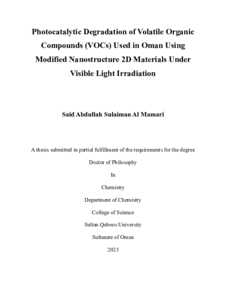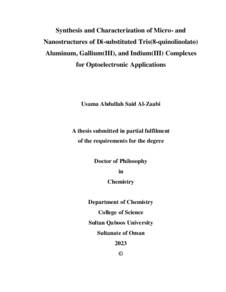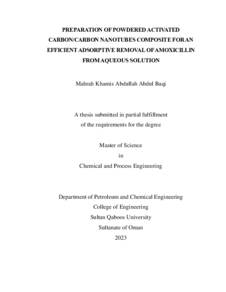وثيقة
Photocatalytic degradation of volatile organic compounds (VOCs) used in Oman using modified nanostructure 2D materials under visible light irradiation.
المصدر
Doctoral dissertation
عناوين أخرى
التحلل الضوئي المحفز للمركبات العضوية المتطايرة والمستخدمة في سلطنة عمان باستخدام مواد ذات بنية نانونية معدلة لتكوين مواد ثنائية الأبعاد تحت إشعاع الضوء المرئي
الدولة
Oman
مكان النشر
Muscat
الناشر
Sultan Qaboos University
ميلادي
2023
اللغة
الأنجليزية
الموضوع
نوع الرسالة الجامعية
Doctoral dissertation
الملخص الإنجليزي
Due to the expanding of the global economic petroleum energy and the need for the 4th
industrial revolution, many of the challenges impact reflected on human life. Pollution would be
cased as a result of that and can affect our small amount drinkable water of our environment. The
industrial activities improvement resides the contamination level of water and rapid the danger on
the plants and human health. Many organic pollutants would persist for long time in the water and
soil. Therefore, finding a green technology solution would be effective. The accumulation of small
concentration of organic pollutants like volatile organic compounds (VOCs) in our freshwater
make us at long path challenges for water treatment. However, many research studies have used
photocatalytic materials in order to reduce the number of VOCs present in water. Still a lot of work
have to be covered in that area with building new design techniques to produce a high active
photocatalytic nanostructured material that are recyclable, cost effective and stable at the same
time.
Semiconductors materials have shown interesting photoactive and redux properties with
high potential to be applied in water treatment. Metal oxides and metal sulfides are well known
semiconductors that are used in photocatalysis processes. Today, metal free semiconductor called
graphitic like carbon nitride (g-C3N4) attracted many researchers due to the dimensional surface
structure, electron rich, easy producing and environmentally friendly compound. The g-C3N4
compound has a medium band gap of 2.7 eV optically active to the light located on the visible
region of the light spectrum. Nonetheless, it shows some drawbacks such as high recombination
rate of electron hole pairs during the photocatalytic reaction. Therefore, the thesis work focused
on restructure the g-C3N4 material by coupling with other semiconductor by hydrothermal,
solvothermal and one-pot pyrolysis techniques targeting produce a heterostructure coordination
that enhance the charge carrier’s movement and photocatalytic activity during the photodegrading
of the VOCs water pollutants under irradiation of visible light.
At the beginning of the research carbon nitride was prepared by thermal treatment form
available precursor. Although there were many precursors which can form pure g-C3N4, the higher
yield was collected from the melamine starting compound. Then the pure g-C3N4 was characterized
to identify the composition, morphology, purity and optical properties. Then, six different pure
materials were produced and coupled with the g-C3N4 nanosheets in order to enhance the
photocatalytic characteristics of the composites.
The prepared pure g-C3N4 nanosheets was identified using different techniques such as
Fourier transform infrared spectroscopy (FTIR), X-ray diffraction (XRD), X-ray photoelectron
spectroscopy (XPS), scanning electronic microscopy (SEM), elemental mapping combined with
energy-dispersive X-ray spectroscopy (EDX), Photoluminescence (PL), electro impedance
spectroscopy (EIS) and UV-vis diffuse reflectance spectroscopy (UV-DRS). The pure g-C3N4
nanosheets were performed for photocatalytic degradation of four different VOCs compounds
contaminants water. Gas chromatography connected with flame ionization detector (GC-FID) and
total organic samples analyzers (TOC) were used to quantify the collected samples during the degradation process.
The g-C3N4 nanosheets were coupled with -Fe2O3 nanoparticles and TiO2 hollow spheres
by solvothermal method to produce -Fe2O3/g-C3N4 and TiO2/g-C3N4 composites with different
ratios. Transmission electron microscopy (TEM), high-resolution HR-TEM, scanning electron
microscopy (SEM) and UV-Vis diffuse reflectance spectroscopy (UV-DRS) were all used to
examine the materials. Band gaps were analysed using UV-DRS. The tests were done to see if
toluene and methyl tetra-butyl ether (MTBE) in water could be photodegraded. In order to improve
the photocatalytic degradation of toluene and MTBE in aqueous solution, this study offers the
characterization of photoexcited charge carriers using a proposed Z-scheme interface of the composite of α-Fe2O3/g-C3N4 as well as TiO2/g-C3N4 composites.
The ZnO/g-C3N4 composites are made by combining hexagonal ZnO lotus buds with
graphitic carbon nitride (g-C3N4) nanosheets employing a one-pot paralysis technique. To
investigate the charge carrier interface for photocatalytic improvement, ZnO/g-C3N4 composites
in various ZnO/g-C3N4 molar ratios were made. The coupling of the ZnO particles to the g-C3N4
nanosheets was investigated via X-ray diffraction (XRD), scanning electron microscopy (SEM),
X-ray photoelectron spectroscopy (XPS), photoluminescence (PL) spectroscopy, ultravioletvisible diffuse reflectance spectroscopy (UV-DRS), and electrochemical impedance spectroscopy
(EIS). The samples were utilized to evaluate if benzene photodegraded in the presence of visible
light. The developed ZnO/g-C3N4 sample showed the enhanced photocatalytic activity for
degradation and had high stability up to five cycles. A Z-scheme for the combined photocatalyst
and degradation process was put forth.
By applying the hydrothermal methods, the g-C3N4 nanosheets were combined with CdS
maple leaf particles to form CdS/g-C3N4 composites. The pure and composite were characterized
using the same analytical techniques presented before. Also, the ready samples were applied for
photodegradation of benzene under visible light irradiation. Moreover, the hydrothermal route was
used to couple g-C3N4 nanosheets with cubic In2O3 particles and ZnIn2S4 nanosheets to form cubic
In2O3/g-C3N4 nanosheets composite and nanosheets ZnIn2S4/g-C3N4 nanosheets composite,
respectively. All the pure materials and composites were applied for photocatalytic degradation of
benzene, MTBE and 1-butanol under visible light irradiation.
The finding results for the collected work in this thesis conformed the enhancement in the
photocatalytic activity of the coupled metal free carbon nitride (g-C3N4) as based material with 2-
dinmantional structure (2D) combined with spherical (0D) -Fe2O3 nanoparticles, spherical (0D)
TiO2 nanoparticles, (3D) louts bud ZnO nanoparticles, (3D) maple leaf CdS nanoparticles, (3D)
cubic In2O3 nanoparticles and (2D) ZnIn2S4 nanosheets. The improvement in the photoactivity for
the composites would be attributed to the development of the heterostructure, higher the separation
of electron hole pairs and the increasing of the active species during the photocatalytic route. The
study shows that composites samples can be applied for water treatment in the wastewater
contaminated with VOCs under visible light irradiation.
الملخص العربي
نظرا لتزايد الطلب العالمي على طاقة البترول وتأثيره على الاقتصاد العالمي والحاجة الى الثورة الصناعية الرابعة، ً أدى ذلك الى ظهور العديد من التحديات على حياة الانسان. ومن أكبر التحديات التلوث المؤثر على كمية المياه الصالحة للشرب في بيئتنا. فازدياد تطور الانشطة الصناعية أدى الى تسريع تلوث المياه مما يشكل خطراً على الغطاء النباتي وصحة الانسان. ق فالعديد من الملوثات العضوية تبقى لفترة طويلة في الماء والتربة. لذلك من المهم إيجاد حل تقني فعال وصدي للبيئة. إن تراكم التراكيز الصغيرة من الملوثات العضوية مثل المركبات العضوية المتطايرة (VOCs (في مياهنا العذبة يجعلنا في تحديات مستمرة وطويلة لمعالجة المياه الملوثة. لذلك استخدمت العديد من الدراسات البحثية مواد التحفيز الضوئي من أجل تقليل عدد المركبات العضوية المتطايرة والملوثة للماء. ال يزال هناك العديد من العمل الذي يتعين تجريبه في هذا المجال من خالل تصميم تقنيات جديدة لإنتاج مواد ذات بنية متناهية في الصغر )نانونية( وذات تحفيز ضوئي عالي الفاعلية ومستقرة ومنخفضة التكلفة وقابلة إلعادة التدوير في نفس الوقت. صا وخصائص كيميائية مثيرة لالهتمام مع إمكانية عالية لتطبيقها في معالجة ً أظهرت مواد أشباه الموصالت خوا ضوئية المياه. فأكاسيد المعادن وكبريتات المعادن هي أشباه موصالت معرفة وتستخدم في عمليات التحفيز الضوئي. فاليوم جذبت أشباه الموصلات الخالية من المعدن مثل نيتريد الكربون )4N3C-g )العديد من الباحثين بسبب بنية الاسطح الغية بالالكترونات وسهولة إنتاجه كما انه صديق للبيئة. يحوي مركب نيتريد الكربون على فجوات ضوئية وذات نطاق متوسط ونشطة في منطقة الضوء المرئي من طيف الضوء. لكن هذه المادة تظهر بعض القصور نتيجة فقد الشحنات النشطة إثناء التحفيز الضوئي. لذلك ركزت الاطروحة على إعادة هيكلة بنية مادة نيتريد الكربون وذلك بإقرانها بأشباه موصالت أخرى باستخدام تقنيات مثل التحضير وأيضا الوعاء الواحد والتي استهدفت انتاج مواد ذات نسق غير متجانس في ً الحراري المائي والحراري باستخدام مذيب تقنية التكوين يعزز حركة حمل الشحنات والنشاط التحفيزي أثناء التحلل الضوئي للمركبات العضوية المتطايرة والملوثة للماء تحت إشعاع الضوء المرئي. تمت دراسة وتحليل المواد المحضرة من حيث النقاوة وخصائص السطح من حيث الشكل والابعاد وكذلك الخواص الضوئية لجميع العينات التي تم انتاجها سواء نيتريد الكربون النقي كمادة أساسية ثنائية الابعاد والمواد النقية قبل دمجها ومواد كبريتيد الكربون المعدلة بعد دمجها باستخدام أجهزة متطورة داخل الجامعة وخارجها، وتم تطبيق المواد المحضرة لدراسة قدرتها وفاعليتها أتناء عملية تحلل المركبات العضوية المتطايرة في الماء تحت اشعة الضواء المرئي. وخلصت النتائج أن نيتريد الكربون المعدل يعطي نتائج أفضل بعد دمجه بأشباه الموصالت الاخرى فتتحسن القدرة على امتصاص الضوء المرئي وتدفق الالكترونات مما ينعكس على زيادة نشاط عملية التحليل الضوئي للمركب العضوية المتطايرة والملوثة للماء.
قالب العنصر
الرسائل والأطروحات الجامعية




